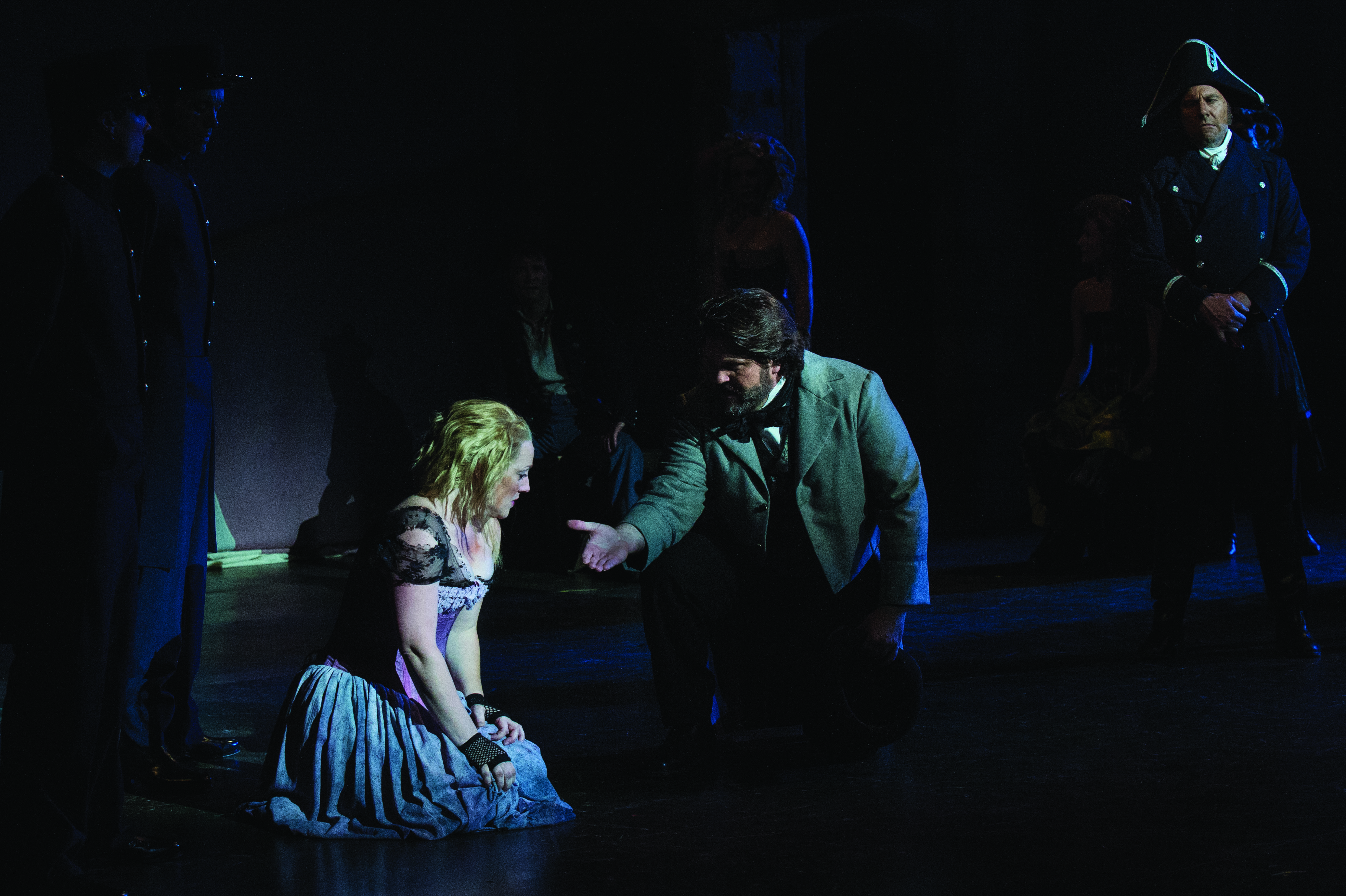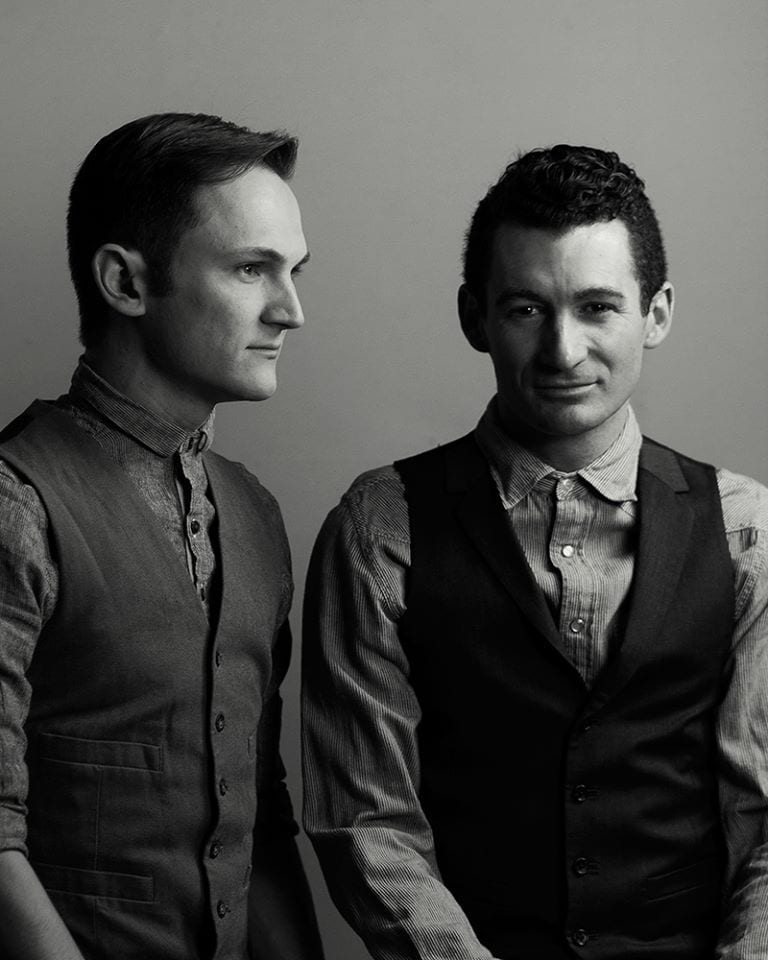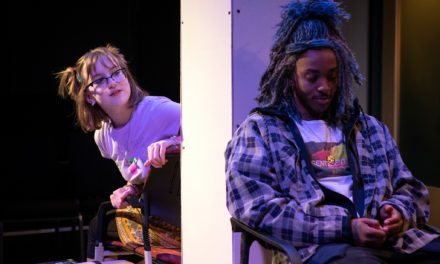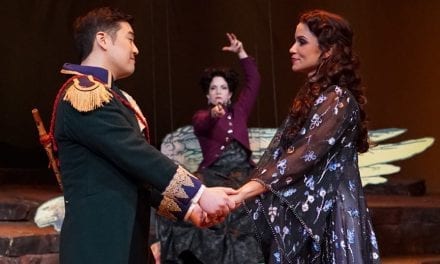CEDAR CITY — There’s a song in Les Misérables called “Empty Chairs at Empty Tables,” where the character of Marius mourns all of his friends he lost in a battle. The lyrics of this song are beautiful and capture well the ambiance of the play. He sings, “There’s a grief that can’t be spoken. There’s a pain goes on and on. Empty chairs at empty tables, now my friends are dead and gone. Phantom faces at the window, phantom shadows on the floor. Empty chairs at empty tables where my friends will meet no more.” This famous musical intimidated me at first, but drew me in with its sadness and yearning melodies.

J. Michael Bailey (left) as Jean Valjean and Tina Scariano as Cosette in the Utah Shakespeare Festival’s 2012 production of Les Misérables. (Photo by Karl Hugh. Copyright Utah Shakespeare Festival 2012.) Show closes October 20, 2012.
In the play, a man named Jean Valjean was arrested for stealing bread, and was labeled—literally branded—a criminal for life. He served his sentence, but is still pursued relentlessly by Inspector Javert, a passionate enforcer of the law. Valjean’s bitter heart is changed by the kindness of a bishop, and Valjean fights to become a different man through helping others (i.e., Fantine, Cossette, Javert, Marius, and others). The story is full of characters who are suffering from poverty, fate, cruelty, and loneliness. I find it so fitting that the title of Les Misérables could be translated variously as “The Miserable Ones,” “The Wretched Ones,” The Poor Ones,” or “The Victims.”
I admire Brad Caroll’s direction in this production, for though I sometimes found myself outside of the story, I was enticed back in time after time. Caroll created very memorable images with his cast. The “Lovely Ladies” scene was done perfectly because I cringed watching it. The whores looked beaten by the world, but held their heads high, the men circled them likes sharks, and the song itself pierced me with its lyrics. They were labeled, like Valjean, but without a number. I thought it was interesting how the women looked confident and proud standing there in the center, but shrunk back, completely changed, when the police showed up; each woman acted in that scene well.
The main character was played by J. Michael Bailey. Never let anyone doubt that talent resides in Utah, because this fantastic Jean Valjean lives in Ogden. Bailey had a great presence onstage and power in every word he sang. My favorite moments from him were the tender ones, as he cared for Cossette, or sang to God. “Bring Him Home” shows Bailey in a soft upper register that still calmly touches me. Throughout the play, Bailey was nothing but amazing. Another fabulous actor was Brian Vaughn as Javert. Vaugn was so expressive, determined, and bold. Moreover, Vaughn’s voice rang out clearly throughout the theater whenever he sang.
The men were impressive, for sure, but the women of Les Mis pulled at my heart. I’m a mom, so I have a definite soft spot for widows, orphans, and abandonment in general. Add to that the glorious vocals and emotional range of Melinda Pfundstein as Fantine, and I’m pretty much a blubbering mess. Pfundstein’s “I Dreamed a Dream” was the first moment I was really sucked into this play. She was such a storyteller and so genuine in her role. Another heart breaker was little orphan Cossette (Sadi Weir) and her sweet “Castle on a Cloud.”
But Barbara Jo Bednarczuk, playing a wonderful Eponine, was my favorite. Eponine had parents, but no comfort or nurturing. The boy she loved never loved her in return. She was such a charming and sad character; Bednarczuk played her brilliantly. I loved her every minute and sat in awe during Bednarczuk’s “On My Own.” There is a great moment when grown Cossette (Tina Scariano) and Marius (Cody Craven) sing of their love for each other, lit from above in beam of pure joy, but Bednarczuk was there too, in the shadows, watching her dreams fade away. This mournful undertone was carried into each aspect of the production.
Jo Winiarski, the scenic designer, created a wonderful set in the Randall L. Jones Theatre, which seats over 700, yet has a stage that feels very close. Winiarski’s designs felt intimate at times and very spacious in others. One up-close moment that I loved was Valjean’s scene with the Bishop (Andy Nagraj). Accompanying Nagraj glorious bass notes were set pieces that seemed to appear around the actors and whoosh off when they were done. Another highlight was the factory gate, front and center, where the poor workers spat their lyrics through the bars. I loved the basic structure of the set, and the details that added to each scene, like the wooden beam with a hanging lantern.
The play was created by Alain Boublil and Claude-Michel Schönberg and is based on Victor Hugo’s lengthy novel of the same name. Consequently, cuts had to be made to fit the story into a production live human beings could sit through. Some of these cuts result, I believe, in unanswered questions, holes, and a choppy feeling to parts of the show. I think this contributed to my feeling of mental and emotional disconnect now and then. I was also bothered by things like a cart that appears out of nowhere to run someone over, people who die with no apparent cause, and all the characters inexplicably following each other from city to city.

Brian Vaughn as Inspector Javert in the Utah Shakespeare Festival’s 2012 production of Les Misérables. (Photo by Karl Hugh. Copyright Utah Shakespeare Festival 2012.)
The biggest thorn in my side, though, was that darn battle. I didn’t understand and could not get behind the “revolution” of Marius’ friends. It’s admirable that this group of students felt empathetic toward the downtrodden populous and wanted to help. But this group of regular guys, playing cards and making jokes, did not create an intense and moving conflict for me. It would have been more compelling if the oppressed common folk had joined or supported them, so the audience could see a and feel the motivation behind the fight. The students were led by the character Enjolras; Joey Benedetto did a fine job with the role, but he didn’t dispel the apathy I felt in each of the group’s scenes. As the student revolutionaries were waiting and watching behind the barricade, I didn’t see any difficulty or hardship. Rather, I saw what looked like a tea party with women and children. For this reason, the songs “Drink with Me” and “Do You Hear the People Sing?” didn’t work for me. However, there were bits and pieces of these scenes that I enjoyed, like the widows and the children witnessing their fallen loved ones. As the barricade was moved off stage, my stomach dropped and I was touched.
There were a few visual details that took me out of the story, although I admit that the most of the designs (by K. L. Alberts) were very fitting. For example, I wasn’t a fan of Fantine’s initial costume. In her lavendar dress, she looked too clean and new; besides her sad face, there was nothing to suggest that she’d been living in this ragged environment. ValJean’s greying hair was an issue as well, as it had a purple tint to it that I couldn’t ignore. Last, Madame Thenardier’s makeup (Krissa Lent, hair and make-up director) was too over the top for me; in close quarters like the Randall L. Jones Theater, I think they could have gotten by with less.
Some aspects of the show stood out in their intentional awfulness. I’m referring to the loathsome couple called the Thènardiers and the degrading life of the prostitutes. Max Robinson and Kymberly Mellen provided much of the comic relief in the show as they portrayed the Thènardiers. Both were pretty much moral scum; Robinson and Mellen were so mean to the young Cossette (Sadi Weir) that I genuinely felt bad for her. When they tried to get a good price from Valjean in exchange for the girl, circus-type music played; it was very fitting for those hilarious and sleazy Thènardiers.
The ensemble was very committed in this show; I noticed it especially in “Master of the House.” George Walker was one member of the ensemble that stood out to me. He actually reminded me of Brian Vaughn, who played Javert. Walker had three or four roles in the show, including Bamatabois, the man who hurts Fantine, and he played each with vigor and talent.
Les Misérables is surrounded by a great deal of hype and many admirers. Sorry, but I can’t say I fell in love at first sight. But I do see the substance in its message, I am impressed by the music (with music direction by Richard Carsey), and I adore many of the songs. The Utah Shakespeare Festival and Brad Carroll have created an outstanding product here, and I am glad to have met this musical in such a fine venue. Those talented men, women, and children should be proud of this show, for it will touch hearts and stick in people’s minds. We’re all looking for that joy, that peace; we’re all more than just a number.

A scene from the Utah Shakespeare Festival’s 2012 production of Les Misérables. (Photo by Karl Hugh. Copyright Utah Shakespeare Festival 2012.)





